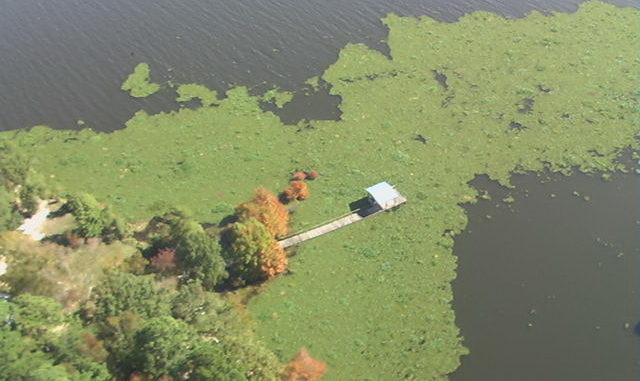
Two thousand acres of giant salvinia on Toledo Bend were treated this weekend by a Texas Parks and Wildlife Department contractor after the invasive species was washed out of the reservoir’s upper reaches into a huge mat that backed up at the Pendleton Bridge.
“We were able to marshal the troops, so we got out there,” TPWD’s Howard Elder told LouisianaSportsman.com today.
TPWD worked with the Sabine River Authority on the $200,000 project.
The massive mat of vegetation formed last week, but Elder said it had pushed through the bridge and been dispersed by a southeast wind by the time he was able to get up in a helicopter for a survey.
“It had broken up and scattered all over the place,” he explained. “So we mapped the largest areas we could find.”
The Texas side of the river was most affected by masses of giant salvinia.
“Indian Mounds was all covered up,” Elder said. “It was in Housen, and we found it all the way up to Patroon. It was scattered along a 16-mile stretch.”
A helicopter began dropping herbicides on the vegetation Friday morning, and continued to work until Sunday.
While the majority of that spraying occurred on the Texas side, Elder said there was no consideration for state boundaries.
“It was primarily concentrated on the Texas side of the reservoir, but we did not pay much attention to whether it was on the Louisiana side or the Texas side,” he said. “It was just a big mat of salvinia that needed to be treated.
“We were just concentrating on the densest concentrations we could find.”
Elder said the heavy rains that flushed the salvinia from the shallow button brush of the upper Sabine River was a mixed blessing.
“It may have reduced the amount of plant matter back in the shallow upper region of the reservoir were we cannot get into, but if we can’t effectively treat it once it reaches the lower end of the reservoir, it’s going to spread,” Elder explained. “Even though we treated 2,000 aces, you can’t treat every single leaf of this stuff, and any little piece that escapes treatment is going to be a new colony.
“We’re going to see it (in new areas) next spring. I guarantee it.”